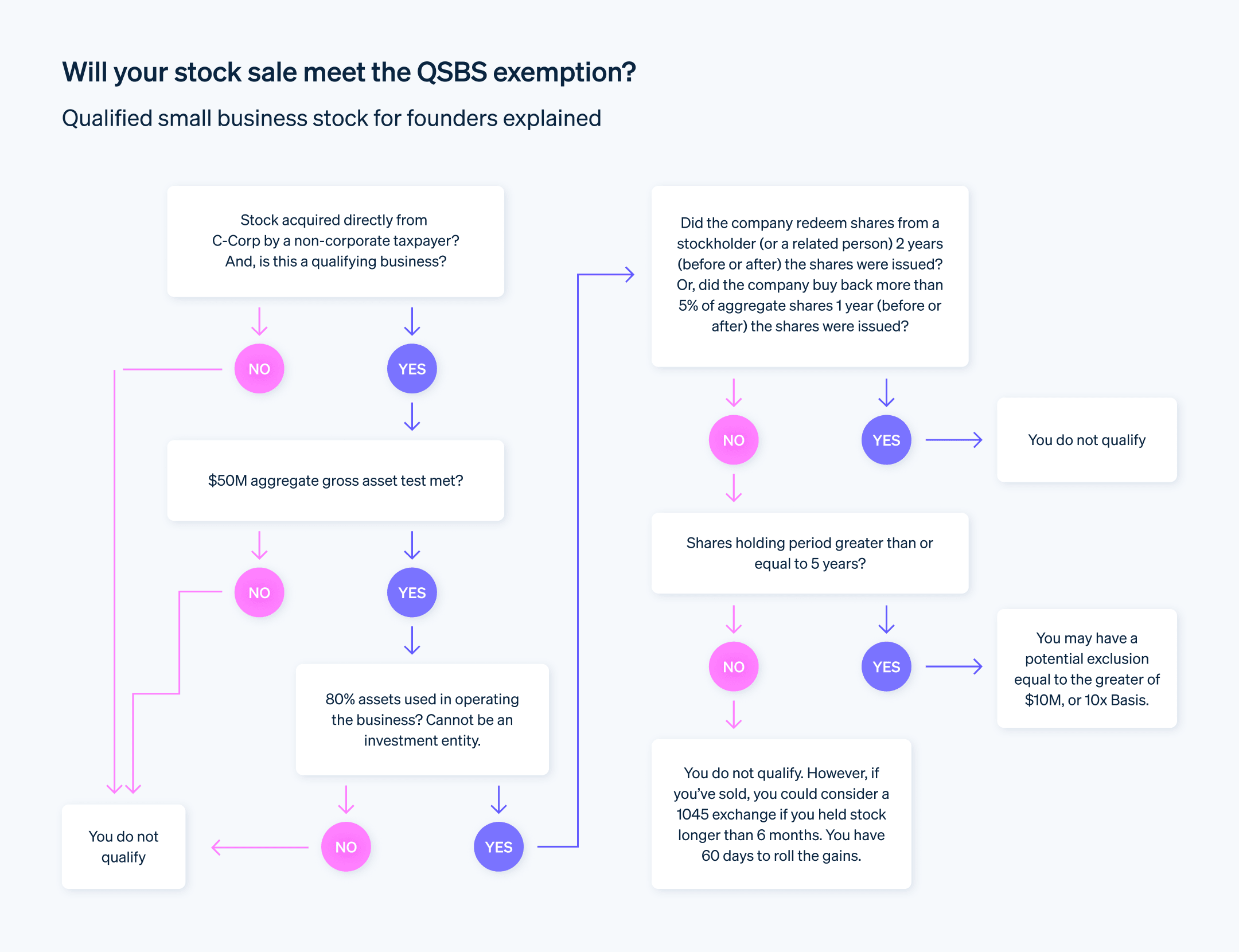持有合格的小企业股票 (QSBS) 可以从根本上改变初创企业创始人和早期投资者的资本利得税负担。他们可以获得高达 1,000 万美元(或原始投资额的 10 倍)的联邦资本利得税 100% 豁免。精明的企业家们越来越多地利用 QSBS 来实现财务回报最大化。
根据美国国家风险投资协会的一份报告,2022 年美国初创企业收购的平均交易价值低于 2 亿美元,这是一个理想的交易价值范围,潜在的 QSBS 免税或减税可能会产生重大影响。但并非所有小企业及其利益相关者都了解如何充分利用这一税收优惠 — 从获取 QSBS 股份到最终出售。
下面,我们将讨论如何获得 QSBS 资格、税收优惠以及可能使股票丧失 QSBS 资格的条件。我们将介绍在发行股票时应使用的估值方法、持续的合规检查以及与持有 QSBS 相关的限制和风险。以下是创始人和早期投资者需要了解的内容。
目录
- 什么是创始人的合格小企业股票 (QSBS)?
- QSBS 资格标准
- 如何获取 QSBS
- 如何出售 QSBS
- QSBS 税收优惠
- QSBS 限制和风险
什么是创始人的合格小企业股票 (QSBS)?
合格小企业股票 (QSBS) 是一种由 C 类公司 (C 公司)发行的符合《国内税收法》(特别是第 1202 和 1045 款)要求的股票。QSBS 为股东(尤其是创始人和早期投资者)提供了大量税收优惠。如果您拥有这种类型的股票,然后将其出售,您可以避免为出售股票所得支付联邦所得税,但最多不超过一定数额。
QSBS 资格标准
要获得 QSBS 的大量税收优惠,发行公司和投资者都需要满足一系列详细要求。这些规则有具体的参数,哪怕是一个参数不符合,都可能导致丧失税收优惠。以下是资格要求的概述:
业务类型
- C 类公司:股票必须由 C 类公司发行。S 类公司和有限责任公司不符合发行 QSBS 的条件。
- 国内:公司应设在美国。外国公司不符合资格。
资产测试
- 总资产:在发行股票时及其后,公司的总资产不得超过 5000 万美元。这包括现金以及按原始成本估价的所有其他资产。
操作标准
- 积极的业务要求:公司至少 80% 的资产价值必须用于积极开展一项或多项合格业务。这不包括被动收入活动,如拥有用于出租的房地产。
股票标准
- 原始问题:投资者必须直接从公司购买股票。二手购买不符合条件。
- 股票类型:只要符合其他标准,普通股或优先股都可以。
持有期
- 五年规则:投资者必须持有股票至少五年才能充分受益于 QSBS 免税。不过,对于持有时间较短的股票,他们可以采用某些展期策略。
排除项限制
- 排除上限:符合免税条件的收益金额以 1,000 万美元或股票计税基础的 10 倍为限。
文档
- 文书工作:发行公司和股东都应保持细致的记录,包括股票证书和财务报表,以确定 QSBS 资格。
这是一份冗长且非常具体的要求清单,但对于创始人和早期投资者来说,经济利益往往是遵守这些要求的充分动力。

如何获取 QSBS
收购 QSBS 涉及一系列经过深思熟虑的步骤。遵守税收规则是关键,但从长远来看,还有一些战略考虑因素可能会影响您的纳税义务和资产增长。获得 QSBS 在税收方面的巨大优势,使其非常值得所需的详细财务、法律和行政工作。
以下是获得 QSBS 的过程概述:
组建 C 类企业
选择在何处注册成立公司会对合规性和运营灵活性产生重大影响。例如,特拉华州是首选,因为其完善的公司法既可预测又对企业有利。
无论您在哪里组建 C 类公司,您都需要向州政府秘书长提交公司章程。这些文件应明确界定关键的组织要素,如企业宗旨、授权股份总数和每股面值。您还需要制定全面的公司章程,以规范内部程序,如董事会会议的召开、投票权以及管理人员的角色和责任。
财务审查
详细的财务审查是获得 QSBS 资格的先决条件。与财务顾问或审计师密切合作,评估您的资产,通常最好的方法是编制一份全面的资产负债表。您还需要确认公司的总资产在发行股票之前和之后都没有超过 5000 万美元的限额。这可能需要第三方资产评估,甚至是全面审计,以获得最大的准确性。
法律顾问
聘请专门从事证券法的法律团队来解决股票发行和 QSBS 合规方面的复杂问题。聘用书将正式确定双方的关系,并明确界定工作范围。该团队应进行合规性审查,以确保股票发行的所有要素都符合联邦和州法规。这通常涉及检查证券豁免和准备必要的备案。
股票文档
起草股票购买协议 (SPA) 和股东协议等合同,以概述股票出售和后续所有权的条款。SPA 将指定购买价格、股份数量以及任何限制,例如归属时间表。股东协议可以通过详细规定投票权、新股优先购买权、跟股或拖股条款等事项来保护股东利益。
保留股票分类账和资本化表对于跟踪股票所有权和在任何潜在的国税局审计中为您提供证据是必须的。
董事会批准
股票发行须经董事会批准,本次会议议程应明确列明相关行动事项。批准发行后,董事会必须将这些决议记录在会议记录中,随后作为公司正式记录的一部分存档。
股票发行
精确记录每股已发行股票。传统的股票证书是所有权的证明,必须包含发行日期、面值和任何限制等详细信息。不过,一些公司选择了基于区块链技术的数字代币,作为所有权的一种安全且易于转让的代表。
持续合规
您必须持续监控是否符合 QSBS 标准。定期进行财务评估,以确保公司的资产价值保持在一定范围内。您还需要定期咨询法律顾问,以确认业务活动是否继续符合 QSBS 资格,因为这些活动会随着业务的发展而发生变化。
如何出售 QSBS
在出售 QSBS 时,请仔细计划并彻底遵循步骤,以保留所有可用的税收优惠并顺利完成交易。出售过程中有许多监管规定、错综复杂的法律框架和复杂的税务影响,但只要有正确的规划和税务顾问的支持,还是可以做到的。以下是出售 QSBS 的方法:
持有期验证:首先,确认您已满足五年持有要求。此期限从股票的原始发行日期开始,到销售之日结束。这种计算方法简单明了,但却是获得 QSBS 税收优惠的绝对必要条件。与税务顾问密切合作,确认持有期限并讨论可能的税务影响。
税务分析:接下来,彻底检查出售的税务后果。请熟悉适用于 QSBS 的税率,因为它们与普通所得税率有很大不同。在成本效益分析中考虑潜在的税收优惠,如在一定限额内免征资本利得税。
文件审查:在启动销售之前,请审查与股票所有权相关的所有文件。这将包括股票购买协议、股东协议和股票证书(如果有的话)。确定并处理影响股票销售的任何限制或权利,如其他股东的优先购买权。
法律咨询:聘请精通证券交易的法律团队准备和审查股票出售所需的所有文件。这通常包括一份买卖协议,其中概述了从销售价格到成交条件等交易条款,以及双方的任何陈述和保证。
为买家提供尽职调查:如果股票销售涉及外部买方,预计他们会自己进行尽职调查。准备好提供所有必要的文件,包括财务报表和知识产权协议。充分合作,同时采取适当措施保护敏感信息。
最终批准:出售的最后阶段可能需要董事会的正式批准,也可能需要股东的投票表决,具体取决于公司章程和州法律。确保记录此审批过程,以建立清晰的书面记录。
结束交易:通过签署所有必要文件完成销售,这些文件通常包括股票购买协议、确认销售的公司决议以及付款转账。每一方都需要保留所有最终执行文件的副本,以便保存记录和将来可能进行的审计。
售后备案和通知:出售完成后,更新公司股票分类账,以反映所有权的变更。您还需要按规定进行监管备案,以记录销售情况并更新股东记录。
税务申报:最后,您需要在纳税申报表上报告 QSBS 的销售情况。记录资本交易一般需要 8949 表和 1040 表的附表 D。请强大的税务顾问确保您正确处理所有细节。
QSBS 出售过程的每一步都很复杂,忽视其中任何一个步骤都可能危及潜在的税收优惠。有了法律和税务顾问的支持,在整个过程中保持合规并获得最佳财务结果就容易多了。
QSBS 税收优惠
虽然处理 QSBS 可能会很繁琐,但由于有许多财务上的好处,因此通常是值得付出努力的。这些包括:
资本收益免税
QSBS 最吸引人的地方之一是可以将大部分资本收益免征联邦税。具体来说,美国国税局允许收益的 100%,最高可达 1,000 万美元,或股票调整基础的 10 倍,以较高者为准。替代性最低税 (AMT) 减免
AMT 是一种单独的所得税计算方法,确保高收入的个人和公司不能通过扣除和免税来逃避最低水平的纳税义务。通常,资本收益排除可能会触发 AMT 考虑。然而,对 QSBS 的免税也适用于反洗钱税,这就为投资者提供了双重减免。展期条款
如果您决定在 60 天内出售您的 QSBS 并将收益再投资于另一个 QSBS,您可以推迟确认资本收益。这样就可以进行具有税收效率的再投资和投资组合调整,而不会立即产生税收后果。州税收优惠
一些州遵守联邦 QSBS 规则,提供与联邦税收优惠类似的州税收优惠。然而,一致性并不具有普遍性,有必要逐州进行分析,以优化潜在的节税效果。降低联邦费率的资格
如果股票不符合完全免税的标准,其收益仍有资格享受联邦资本利得税的减税优惠,其税率可能大大低于普通所得税税率。免税股息
发行 QSBS 的公司通常处于成长阶段,很可能会将利润进行再投资,而不是作为股息进行分配。这就将策略转向了长期资本增值,在免税限额内是免税的。除外责任的可转让性
在某些情况下,QSBS 的税收优惠可以转移到信托或传给继承人,从而保持跨代的税收效率。损失处理
虽然 QSBS 的主要重点是收益,但损失也可以得到特殊处理。在某些情况下,出售 QSBS 的损失可被视为普通损失,而不是资本损失,从而提供更优惠的税收待遇。通过直通实体进行投资
您还可以通过某些转手实体(如合伙企业或 S 公司)持有 QSBS。税收优惠可以流向成员个人,但有一些复杂性和限制。
QSBS 的真正优势在于将这些优势整合到一个连贯的、多层次的税收战略中。每项优势在与其他优势相结合时都会被放大,从而推动更大的资产增长和风险缓解。
QSBS 限制和风险
尽管 QSBS 在财务方面有很多好处,但也要考虑它的缺点。以下是您在获取、持有和出售 QSBS 时应了解的避免错误的知识:
持有期
主要限制之一是五年持有期要求。要获得 QSBS 待遇,您必须持有股票五年以上。如果未在这一时限内完成,则可能丧失税收优惠。资产限额
QSBS 资格适用于在股票发行后立即拥有总资产不超过 5000 万美元的公司。超过这一限额可能会取消新股的 QSBS 资格。符合条件的企业
并非所有行业都有资格获得 QSBS。医疗保健、法律和金融等服务行业通常不符合条件。了解有关哪些企业类型符合或不符合资格的更多详情。税率变化
QSBS 福利与税法挂钩,而税法可能会发生变化。立法可能会修改或取消这些福利,从而使长期规划具有一定的不确定性。持股比例
个人可以从总收入中扣除的 QSBS 数量是有限制的,这通常取决于公司所有权的百分比。投资者应了解这些细微差别,以免在报税时出现意外。州税
虽然 QSBS 提供联邦税收优惠,但各州的税收待遇可能差别很大。有些州遵守联邦规则,有些州则完全不承认 QSBS 福利 — 最明显的是加利福尼亚州。资本损失
如果企业倒闭,那么 QSBS 的损失就会被视为资本损失,这有自己的一套税收规则和限制。与普通商业损失不同,资本损失在扣除方面有限制。
Stripe Atlas 如何提供助力
Stripe Atlas 可为贵公司搭建法律框架,助贵公司在全球任意地点仅需两个工作日即可完成融资、开设银行账户及接受付款。
已有超 7.5 万家企业通过 Stripe Atlas 完成注册,其中包括获 Y Combinator、a16z 及 General Catalyst 等顶级投资机构支持的初创公司。
申请加入 Atlas
使用 Stripe Atlas 申请注册公司仅需不到 10 分钟。贵方可自主选择公司架构,即时核验公司名称是否可用,并添加最多四位联合创始人。贵方还需确定股权分配方案,为未来投资者和员工预留股权池,任命公司高管,最后通过电子签名签署所有文件。所有联合创始人也将收到邮件邀请,通过电子签名签署其对应文件。
在获取雇主识别号 (EIN) 前开通收款与银行账户功能
公司注册完成后,Stripe Atlas 将为贵方申请雇主识别号 (EIN)。持有美国社保号、美国地址及手机号码的创始人可享受美国国税局 (IRS) 加急处理服务,其他情况将适用标准处理流程(耗时可能稍长)。此外,Stripe Atlas 支持在 EIN 获批前开通收款与银行账户功能,助您在等待税务编号期间即可开展交易。
无现金式创始人股票认购
创始人可使用知识产权(如版权或专利)替代现金认购初始股份,相关认购凭证将存储于贵方 Atlas 管理后台。使用该功能需满足知识产权估值不超过 100 美元的条件;若您持有的知识产权价值高于此限额,请在操作前咨询专业律师。
自动提交 83(b) 税务申报
创始人可通过提交 83(b) 税务申报降低个人所得税负。无论贵方是美国籍或非美国籍创始人,Stripe Atlas 均可代为完成申报流程——采用 USPS 认证邮件寄送并附带物流追踪服务。贵方可直接在 Stripe 管理后台获取已签收的 83(b) 申报表及官方寄送凭证。
全球顶尖水准的公司法律文件
Atlas 为贵方提供创办公司所需的全部法律文件。Atlas 的 C 类股份有限公司文件由全球顶尖风投律所美国科律律师事务所 Cooley 联合设计,旨在助贵方立即启动融资,并确保公司获得全方位法律保护,涵盖股权架构、权益分配及税务合规等核心领域。
Stripe 支付服务首年免费,更享价值 5 万美元的合作伙伴专属优惠与折扣
Atlas 与顶级合作伙伴深度联动,为创始人提供独家优惠与资源支持,涵盖 AWS、Carta、Perplexity 等行业领军企业的工程开发、税务合规、财务管理及运营必备工具折扣,更免费赠送首年特拉华州法定注册代理服务。作为 Atlas 用户,贵方还将解锁 Stripe 专属权益——最高 10 万美元交易额的全年免费支付处理服务。
了解更多关于 Atlas 如何助您极速开启创业之旅,即刻启航。
本文中的内容仅供一般信息和教育目的,不应被解释为法律或税务建议。Stripe 不保证或担保文章中信息的准确性、完整性、充分性或时效性。您应该寻求在您的司法管辖区获得执业许可的合格律师或会计师的建议,以就您的特定情况提供建议。